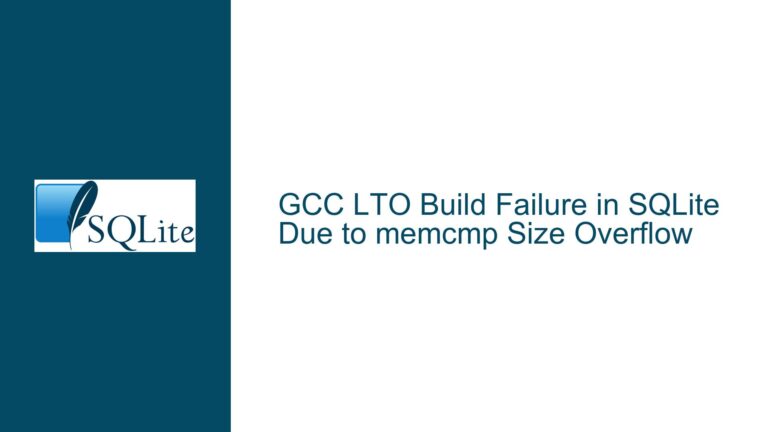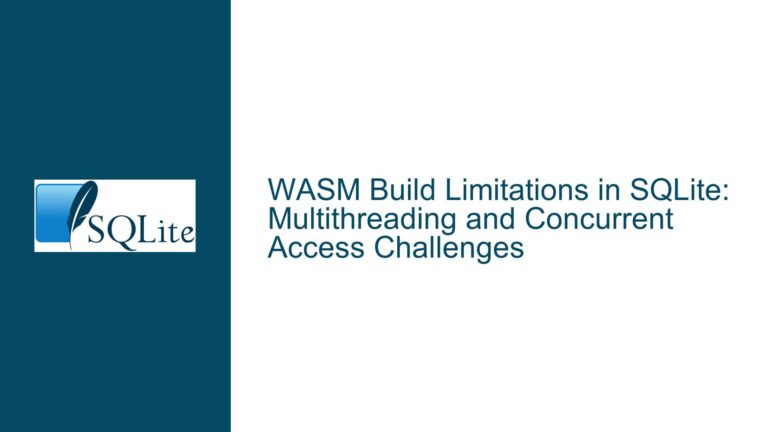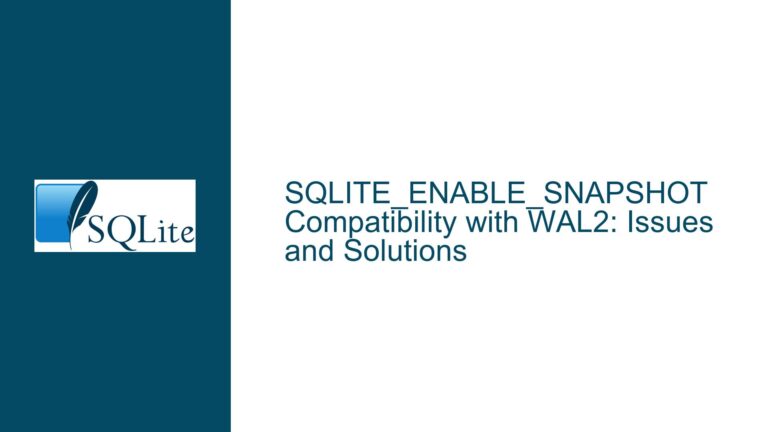SQLite RBU Vacuum Fails with SQLITE_OMIT_WAL and Unix-like OS Constraints
Issue Overview: RBU Vacuum Fails When SQLITE_OMIT_WAL is Enabled on Unix-like OS Without mmap() Support
The core issue revolves around the failure of the SQLite RBU (Resumable Bulk Update) vacuum operation when the SQLITE_OMIT_WAL compile-time option is enabled. The problem is exacerbated when running on a Unix-like operating system that lacks support for essential system APIs such as fcntl, mmap, and related functions. The RBU vacuum operation works correctly when SQLITE_OMIT_WAL is not defined, but enabling this option causes the process to crash or return an I/O error. This behavior is particularly problematic for systems with constrained environments, such as embedded systems or custom Unix-like OS implementations, where certain POSIX-compliant APIs are unavailable.
The RBU extension in SQLite is designed to perform large-scale updates or vacuums in a resumable manner, allowing the operation to be paused and resumed without losing progress. However, RBU relies heavily on the Write-Ahead Logging (WAL) mechanism, which is disabled when SQLITE_OMIT_WAL is defined. WAL mode is essential for RBU because it allows concurrent reads and writes during the vacuum process, ensuring data consistency and performance. Without WAL, RBU cannot function as intended, leading to the observed failures.
Additionally, the Unix-like OS in question uses a custom filesystem (PJFS) that does not support mmap() or other shared memory mechanisms required by WAL mode. This limitation further complicates the issue, as WAL mode typically relies on memory-mapped files for efficient synchronization between processes. The absence of these APIs makes it impossible to use WAL mode in its default configuration, forcing the user to seek alternative solutions.
Possible Causes: Misconfiguration, Unsupported Compile-Time Options, and OS Limitations
The failure of the RBU vacuum operation when SQLITE_OMIT_WAL is enabled can be attributed to several factors, including misconfiguration, the use of unsupported compile-time options, and inherent limitations of the operating system and filesystem.
Misconfiguration of Compile-Time Options: The user has enabled a combination of compile-time options, including
SQLITE_OMIT_WAL,SQLITE_ENABLE_RBU, and others, which may conflict with each other. Specifically,SQLITE_OMIT_WALdisables the Write-Ahead Logging mechanism, which is a critical dependency for RBU. The SQLite documentation explicitly warns thatSQLITE_OMIT_*options are unsupported and may cause malfunctions. EnablingSQLITE_OMIT_WALwhile also enablingSQLITE_ENABLE_RBUcreates an unsupported configuration that is not guaranteed to work.Unsupported Combination of Features: RBU is designed to work with WAL mode, and disabling WAL mode through
SQLITE_OMIT_WALremoves a core dependency of RBU. The RBU extension relies on WAL mode to manage concurrent access to the database during the vacuum process. Without WAL, RBU cannot ensure data consistency or provide the resumable behavior it is designed for. This unsupported combination of features leads to runtime errors, such as crashes or I/O errors, when attempting to perform an RBU vacuum.Operating System and Filesystem Limitations: The Unix-like OS in question uses a custom filesystem (PJFS) that lacks support for essential APIs such as
mmap(),fcntl(), and other shared memory mechanisms. These APIs are required by WAL mode to manage memory-mapped files and ensure efficient synchronization between processes. The absence of these APIs makes it impossible to use WAL mode in its default configuration, even ifSQLITE_OMIT_WALis not defined. This limitation forces the user to either modify the OS/filesystem or find alternative solutions for using RBU without WAL.Incorrect Use of PRAGMA locking_mode=EXCLUSIVE: The user attempted to use the
PRAGMA locking_mode=EXCLUSIVEstatement to avoid shared memory usage in WAL mode. However, this approach was not implemented correctly, as the statement was placed in the wrong location within the code. Additionally, the user misunderstood the relationship betweenPRAGMA locking_mode=EXCLUSIVEand theSQLITE_DEFAULT_LOCKING_MODEcompile-time option. The former is a runtime setting that must be applied after opening the database connection, while the latter is a compile-time option that sets the default locking mode for all connections.
Troubleshooting Steps, Solutions & Fixes: Addressing the RBU Vacuum Failure and OS Constraints
To resolve the RBU vacuum failure and address the constraints imposed by the Unix-like OS and custom filesystem, the following steps and solutions can be implemented:
Avoid Using SQLITE_OMIT_WAL with RBU: The most straightforward solution is to avoid enabling
SQLITE_OMIT_WALwhen using the RBU extension. Since RBU relies on WAL mode for its functionality, disabling WAL mode throughSQLITE_OMIT_WALwill always result in failures. Instead, ensure that WAL mode is enabled and functioning correctly. If WAL mode cannot be used due to OS or filesystem limitations, consider alternative approaches, such as using a different database engine or modifying the OS/filesystem to support the required APIs.Use PRAGMA locking_mode=EXCLUSIVE Correctly: If WAL mode must be used but shared memory mechanisms are unavailable, the
PRAGMA locking_mode=EXCLUSIVEstatement can be used to avoid shared memory usage. However, this statement must be executed immediately after opening the database connection, not within the SQLite amalgamation code. For example:sqlite3 *db; int rc = sqlite3_open("database.sqlite", &db); if (rc == SQLITE_OK) { rc = sqlite3_exec(db, "PRAGMA locking_mode=EXCLUSIVE", 0, 0, 0); if (rc != SQLITE_OK) { // Handle error } }This approach ensures that the database connection uses exclusive locking mode, avoiding the need for shared memory. Note that this may impact performance and concurrency, as exclusive locking mode prevents other processes from accessing the database simultaneously.
Modify the OS/Filesystem to Support Required APIs: If the Unix-like OS and custom filesystem lack support for essential APIs such as
mmap()andfcntl(), consider modifying the OS or filesystem to add support for these APIs. This may involve implementing custom drivers or modifying the filesystem implementation to provide the necessary functionality. While this approach requires significant effort, it may be the only viable solution for using WAL mode and RBU in constrained environments.Explore Alternative Database Engines: If modifying the OS or filesystem is not feasible, consider using a different database engine that does not rely on WAL mode or shared memory mechanisms. For example, some lightweight databases use alternative concurrency control mechanisms that may be more suitable for constrained environments. However, this approach may require significant changes to the application and should be carefully evaluated.
Custom Build of SQLite with Modified WAL Implementation: As a last resort, consider creating a custom build of SQLite with a modified WAL implementation that does not rely on
mmap()or shared memory. This approach requires deep knowledge of SQLite’s internals and may involve significant development effort. The modified WAL implementation could use alternative synchronization mechanisms, such as file-based locks or custom memory management, to achieve the same functionality without relying on unsupported APIs.Consult SQLite Documentation and Community: Before attempting any of the above solutions, consult the SQLite documentation and community for additional guidance. The SQLite documentation provides detailed information on compile-time options, WAL mode, and RBU, as well as warnings about unsupported configurations. The SQLite community, including forums and mailing lists, can provide valuable insights and recommendations based on similar experiences.
By carefully evaluating the constraints and implementing the appropriate solutions, it is possible to resolve the RBU vacuum failure and achieve the desired functionality in constrained environments. However, it is important to recognize the limitations imposed by the OS and filesystem and to choose the solution that best aligns with the application’s requirements and constraints.






